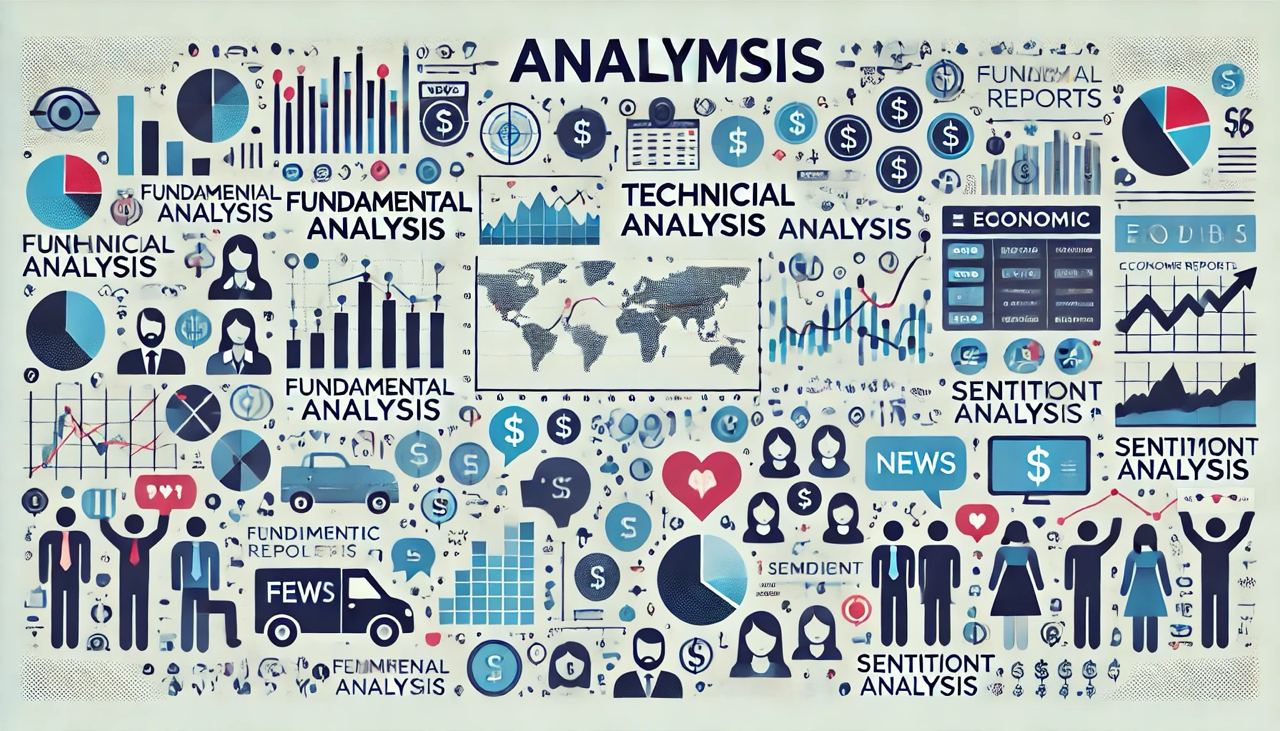Learn Trading for Free and Without Registration
An Online Glossary to Study Trading Independently
Forex Market Analysis
Types of Financial Market Analysis: An Overview of Key Methods

Analyzing financial markets is the cornerstone of successful trading and investing. A variety of approaches enables traders and investors to find strategies that minimize risks and maximize profits. All analytical methods can be divided into several main categories, each with its advantages, disadvantages, and areas of application.
1. Fundamental Analysis
Fundamental analysis focuses on studying global economic factors that influence asset prices. This method helps understand why the market moves in certain directions and forecast long-term trends.
Key aspects of fundamental analysis:
- Economic indicators: GDP, unemployment rate, inflation, interest rates, and other macroeconomic data significantly affect currencies, stocks, and other assets.
- Political events: Policy changes, elections, sanctions, and trade wars can heavily impact the market.
- News and reports: Key events like corporate earnings releases or economic reports play a critical role in price formation.
Advantages:
- Explains long-term trends.
- Accounts for a wide range of factors influencing the market.
Disadvantages:
- High complexity due to numerous variables.
- Requires significant time and resources to monitor news and prepare for unexpected market events.
2. Technical Analysis
Technical analysis relies on studying charts and historical data. It assumes that price behavior reflects all external factors, making it possible to predict future market movements based on this information.
Key subtypes of technical analysis:
-
Indicator-based analysis:
Uses mathematical indicators (such as moving averages, RSI, and MACD) to identify trends, entry, and exit points. -
Chart pattern analysis:
Focuses on patterns like head and shoulders, double tops, and triangles to predict price movements. Ideal for beginners. -
Wave analysis:
Based on Elliott Wave Theory, which assumes market movements are cyclical. This is a complex but powerful tool for experienced traders. -
Candlestick analysis:
Examines Japanese candlestick patterns to identify market sentiment (e.g., hammer, engulfing, doji). It is popular for its accuracy and visual clarity.
Advantages:
- Easy to use for short-term trading.
- Suitable for automating strategies.
Disadvantages:
- Limited by historical data.
- Can produce false signals when market conditions change.
3. Volume Analysis
Volume analysis is based on studying trading volumes to identify market activity. It helps detect the actions of large players, assess trend strength, and pinpoint key support and resistance levels.
Key tools for volume analysis:
- Cluster charts: Show volume distribution across different price levels.
- Market profiles: Display where the majority of trades have occurred.
Advantages:
- Reveals the behavior of large market participants.
- Useful for intraday trading.
Disadvantages:
- Requires specialized software.
- Less accessible for beginners.
4. Sentiment Analysis
This method evaluates market participants' sentiment to determine whether the market is predominantly bullish or bearish.
Sentiment analysis tools:
- Sentiment indices (e.g., Fear and Greed Index).
- Positions of traders in futures markets.
- Open interest statistics for options and futures.
Advantages:
- Helps identify overbought or oversold markets.
- Can confirm signals from other analysis types.
Disadvantages:
- Subjective and less precise.
- Sensitive to short-term changes in market sentiment.
5. Intermarket (Cross-Market) Analysis
This approach studies the relationships between different markets, such as commodities, stocks, currencies, and bonds.
Examples of intermarket relationships:
- Rising oil prices often lead to a stronger Canadian dollar.
- Increasing interest rates can negatively affect stock markets.
Advantages:
- Provides a comprehensive view of financial market movements.
- Helps understand macroeconomic trends.
Disadvantages:
- Requires extensive data and interpretive skills.
- Can be complex for beginners.
Conclusion
Each of the described analytical methods has its strengths and weaknesses. Successful trading in financial markets often requires combining several approaches. For example, fundamental analysis can help identify long-term trends, while technical analysis is useful for finding entry and exit points.
The key to effective analysis lies in continuous learning and adapting to changing market conditions. The better you understand the tools and methods, the more likely you are to build a successful trading strategy and achieve consistent profitability.


